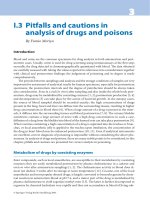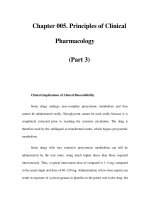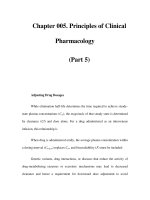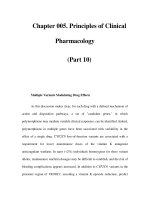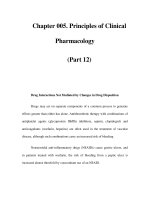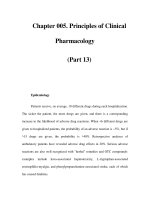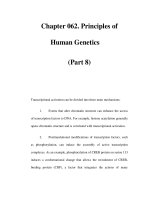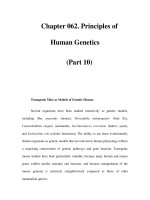ABC OF CLINICAL GENETICS - PART 3 doc
Bạn đang xem bản rút gọn của tài liệu. Xem và tải ngay bản đầy đủ của tài liệu tại đây (316.25 KB, 13 trang )
18
Abnormalities of the autosomal chromosomes generally cause
multiple congenital malformations and mental retardation.
Children with more than one physical abnormality and
developmental delay or learning disability should therefore
undergo chromosomal analysis as part of their investigation.
Chromosomal disorders are incurable but most can be reliably
detected by prenatal diagnostic techniques. Amniocentesis or
chorionic villus sampling should be offered to women whose
pregnancies are at increased risk – namely, couples in whom
one partner carries a balanced translocation, women identified
by biochemical screening for Down syndrome and couples who
already have an affected child. Unfortunately, when there is no
history of previous abnormality the risk in many affected
pregnancies cannot be predicted before the child is born.
Down syndrome
Down syndrome, due to trisomy 21, is the commonest
autosomal trisomy with an overall incidence in liveborn infants
of between 1 in 650 and 1 in 800. Most conceptions with
trisomy 21 do not survive to term. Two thirds of conceptions
miscarry by mid-trimester and one third of the remainder
subsequently die in utero before term. The survival rate for
liveborn infants is surprisingly high with 85% surviving into
their 50s. Congenital heart defects remain the major cause of
early mortality, but additional factors include other congenital
malformations, respiratory infections and the increased risk of
leukaemia.
An increased risk of Down syndrome may be identified
prenatally by serum biochemical screening tests or by detection
of abnormalities by ultrasound scanning. Features indicating an
increased risk of Down syndrome include increased first
trimester nuchal translucency or thickening, structural heart
defects and duodenal atresia. Less specific features include
choroid plexus cysts, short femori and humeri, and echogenic
bowel. In combination with other risk factors their presence
indicates the need for diagnostic prenatal chromosome tests.
The facial appearance at birth usually suggests the presence
of the underlying chromosomal abnormality, but clinical
diagnosis can be difficult, especially in premature babies, and
should always be confirmed by cytogenetic analysis. In addition
to the facial features, affected infants have brachycephaly, a
short neck, single palmar creases, clinodactyly, wide gap
between the first and second toes, and hypotonia. Older
children are often described as being placid, affectionate and
music-loving, but they display a wide range of behavioural and
personality traits. Developmental delay becomes more apparent
in the second year of life and most children have moderate
learning disability, although the IQ can range from 20 to 85.
Short stature is usual in older children and hearing loss and
visual problems are common. The incidence of atlanto-axial
instability, hypothyroidism and epilepsy is increased. After the
age of 40 years, neuropathological changes of Alzheimer
disease are almost invariable.
Down syndrome risk
Most cases of Down syndrome (90%) are due to nondisjunction
of chromosome 21 arising during the first meiotic cell division
in oogenesis. A small number of cases arise in meiosis II during
oogenesis, during spermatogenesis or during mitotic cell
division in the early zygote. Although occurring at any age, the
5 Common chromosomal disorders
Figure 5.1 Child with dysmorphic facial features and developmental
delay due to deletion of chromosome 18(18q-)
Figure 5.2 Trisomy 21 (47, XX ϩ21) in Down syndrome (courtesy of
Dr Lorraine Gaunt and Helena Elliott, Regional Genetic Service, St
Mary’s Hospital, Manchester)
Figure 5.3 Nondisjunction of chromosome 21 leading to Down
syndrome
Parents
Gametes
Offspring
Non-viable
Trisomy 21
Nondisjunction
21
21
acg-05 11/20/01 7:17 PM Page 18
Common chromosomal disorders
19
risk of having a child with trisomy 21 increases with maternal
age. This age-related risk has been recognised for a long time,
but the underlying mechanism is not understood. The risk of
recurrence for any chromosomal abnormality in a liveborn
infant after the birth of a child with trisomy 21 is increased by
about 1% above the population age related risk. The risk is
probably 0.5% for trisomy 21 and 0.5% for other chromosomal
abnormalities. This increase in risk is more significant for
younger women. In women over the age of 35 the increase in
risk related to the population age-related risk is less apparent.
Population risk tables for Down syndrome and other trisomies
have been derived from the incidence in livebirths and the
detection rate at amniocentesis. Because of the natural loss of
affected pregnancies, the risk for livebirths is less than the risk
at the time of prenatal diagnosis. Although the majority of
males with Down syndrome are infertile, affected females who
become pregnant have a high risk (30–50%) of having a Down
syndrome child.
Translocation Down syndrome
About 5% of cases of Down syndrome are due to translocation,
in which chromosome 21 is translocated onto chromosome 14
or, occasionally, chromosome 22. In less than half of these cases
one of the parents has a balanced version of the same
translocation. A healthy adult with a balanced translocation
has 45 chromosomes, and the affected child has 46
chromosomes, the extra chromosome 21 being present
in the translocation form. The risk of Down syndrome in
offspring is about 10% when the balanced translocation is
carried by the mother and 2.5% when carried by the father. If
neither parent has a balanced translocation, the chromosomal
abnormality in an affected child represents a spontaneous,
newly arising event, and the risk of recurrence is low (Ͻ1%).
Recurrence due to parental gonadal mosaicism cannot be
completely excluded.
Occasionally, Down syndrome is due to a 21;21
translocation. Some of these cases are due to the formation of
an isochromosome following the fusion of sister chromatids. In
cases of true 21;21 Robertsonian translocation, a parent who
carries the balanced translocation would be unable to have
normal children (see figure 5.6).
When a case of translocation Down syndrome occurs it is
important to test other family members to identify all carriers
of the translocation whose pregnancies would be at risk.
Couples concerned about a family history of Down syndrome
can have their chromosomes analysed from a sample of blood
to exclude a balanced translocation if the karyotype of the
affected person is not known. This usually avoids unnecessary
amniocentesis during pregnancy.
Figure 5.4 Down syndrome due to Robertsonian translocation between
chromosomes 14 and 21 (courtesy of Dr Lorraine Gaunt and Helena
Elliott, Regional Genetic Service, St Mary’s Hospital, Manchester)
Figure 5.5 Possibilities for offspring of a 14;21 Robertsonian
translocation carrier
21 14
21 14
Carrier of balanced
translocation
Non-viable Non-viable Non-viable
Normal
Balanced
translocation
Down
syndrome
Normal spouse
Box 5.1 Risk of Down syndrome in livebirths and at
amniocentesis
Maternal age Liveborn Risk at
(at delivery or risk amniocentesis
amniocentesis)
All ages 1 in 650
Age 30 1 in 900
Age 35 1 in 385 1 in 256
Age 36 1 in 305 1 in 200
Age 37 1 in 240 1 in 156
Age 38 1 in 190 1 in 123
Age 39 1 in 145 1 in 96
Age 40 1 in 110 1 in 75
Age 44 1 in 37 1 in 29
Figure 5.6 Possibilities for offspring of a 21;21 Robertsonian
translocation carrier
21
21
Normal spouse
Parents
Down syndrome
in all offspring
Carrier of balanced
21; 21 translocation
Non-viable
Gametes
Offspring
acg-05 11/20/01 7:17 PM Page 19
ABC of Clinical Genetics
20
Other autosomal trisomies
Trisomy 18 (Edwards syndrome)
Trisomy 18 has an overall incidence of around 1 in 6000 live
births. As with Down syndrome most cases are due to
nondisjunction and the incidence increases with maternal age.
The majority of trisomy 18 conceptions are lost spontaneously
with only about 2.5% surviving to term. Many cases are now
detectable by prenatal ultasound scanning because of a
combination of intrauterine growth retardation,
oligohydramnios or polyhydramnios and major malformations
that indicate the need for amniocentesis. About one third of
cases detected during the second trimester might survive to
term. The main features of trisomy 18 include growth
deficiency, characteristic facial appearance, clenched hands
with overlapping digits, rocker bottom feet, cardiac defects,
renal abnormalities, exomphalos, myelomeningocele,
oesophageal atresia and radial defects. Ninety percent of
affected infants die before the age of 6 months but 5% survive
beyond the first year of life. All survivors have severe mental
and physical disability. The risk of recurrence for any trisomy is
probably about 1% above the population age-related risk.
Recurrence risk is higher in cases due to a translocation where
one of the parents is a carrier.
Trisomy 13 (Patau syndrome)
The incidence of trisomy 13 is about 1 per 15 000 live births.
The majority of trisomy 13 conceptions spontaneously abort in
early pregnancy. About 75% of cases are due to nondisjunction,
and are associated with a similar overall risk for recurrent trisomy
as in trisomy 18 and 21 cases. The remainder are translocation
cases, usually involving 13;14 Robertsonian translocations. Of
these, half arise de novo and half are inherited from a carrrier
parent. The frequency of 13;14 translocations in the general
population is around 1 in 1000 and the risk of a trisomic
conception for a carrier parent appears to be around 1%. The
risk of recurrence after the birth of an affected child is low but
difficult to determine. Prenatal ultrasound scanning will detect
abnormalities leading to a diagnosis in about 50% of cases. Most
liveborn affected infants succumb within hours or weeks of
delivery. Eighty percent die within 1 month, 3% survive to 6
months. The main features of trisomy 13 include structural
abnormalities of the brain, particularly microcephaly and
holoprosencephaly (a developmental defect of the forebrain),
facial and eye abnormalities, cleft lip and palate, postaxial
polydactyly, congenital heart defects, renal abnormalities,
exomphalos and scalp defects. Survivors have very severe mental
and physical disability, usually with associated epilepsy, blindness
and deafness.
Chromosomal mosaicism
After fertilisation of a normal egg nondisjunction may occur
during a mitotic division in the developing embryo giving rise
to daughter cells that are trisomic and nulisomic for the
chromosome involved in the disjunction error. The nulisomic
cell would not be viable, but further cell division of the trisomic
cell, along with those of the normal cells, leads to chromosomal
mosaicism in the fetus. Alternatively a chromosome may be lost
from a cell in an embryo that was trisomic for that
chromosome at conception. Further division of this cell would
lead to a population of cells with a normal karyotype, again
resulting in mosaicism. In Down syndrome mosaicism, for
example, one cell line has a normal constitution of
46 chromosomes and the other has a constitution of 47 ϩ 21.
Figure 5.7 Trisomy 18 mosaicism can be associated with mild to
moderate developmental delay without congenital malformations or
obvious dysmorphic features
Figure 5.8 Features of trisomy 13 include a) post-axial polydactyly
b)scalp defects and c)mid-line cleft lip and palate (courtesy of Professor
Dian Donnai, Regional Genetic Service, St Mary’s Hospital, Manchester)
Figure 5.9 Mild facial dysmorphism in a girl with mosaic trisomy 21
a
b
c
acg-05 11/20/01 7:17 PM Page 20
Common chromosomal disorders
21
The proportion of each cell line varies among different tissues
and this influences the phenotypic expression of the disorder.
The severity of mosaic disorders is usually less than non-mosaic
cases, but can vary from virtually normal to a phenotype
indistinguishable from full trisomy. In subjects with mosaic
chromosomal abnormalities the abnormal cell line may not be
present in peripheral lymphocytes. In these cases, examination
of cultured fibroblasts from a skin biopsy specimen is needed to
confirm the diagnosis.
The clinical effect of a mosaic abnormality detected
prenatally is difficult to predict. Most cases of mosaicism for
chromosome 20 detected at amniocentesis, for example, are
not associated with fetal abnormality. The trisomic cell line is
often confined to extra fetal tissues, with neonatal blood and
fibroblast cultures revealing normal karyotypes in infants
subsequently delivered at term. In some cases, however, a
trisomic cell line is detected in the infant after birth and this
may be associated with physical abnormalities or developmental
delay.
Mosaicism for a marker (small unidentified) chromosome
carries a much smaller risk of causing mental retardation if
familial, and therefore the parents need to be investigated
before advice can be given. Chromosomal mosaicism detected
in chorionic villus samples often reflects an abnormality
confined to placental tissue that does not affect the fetus.
Further analysis with amniocentesis or fetal blood sampling may
be indicated together with detailed ultrasound scanning.
Translocations
Robertsonian translocations
Robertsonian translocations occur when two of the acrocentric
chromosomes (13, 14, 15, 21, or 22) become joined together.
Balanced translocation carriers have 45 chromosomes but no
significant loss of overall chromosomal material and they are
almost always healthy. In unbalanced translocation karyotypes
there are 46 chromosomes with trisomy for one of the
chromosomes involved in the translocation. This may lead to
spontaneous miscarriage (chromosomes 14, 15, and 22) or
liveborn infants with trisomy (chromosomes 13 and 21).
Unbalanced Robertsonian translocations may arise
spontaneously or be inherited from a parent carrying a
balanced translocation. (Translocation Down syndrome is
discussed earlier in this chapter.)
Reciprocal translocations
Reciprocal translocations involve exchange of chromosomal
segments between two different chromosomes, generated by
the chromosomes breaking and rejoining incorrectly. Balanced
reciprocal translocations are found in one in 500–1000 healthy
people in the population. When an apparently balanced
recriprocal translocation is detected at amniocentesis it is
important to test the parents to see whether one of them
carries the same translocation. If one parent is a carrier, the
translocation in the fetus is unlikely to have any phenotypic
effect. The situation is less certain if neither parent carries the
translocation, since there is some risk of mental disability or
physical effect associated with de novo translocations from
loss or damage to the DNA that cannot be seen on
chromosomal analysis. If the translocation disrupts an
autosomal dominant or X linked gene, it may result in a
specific disease phenotype.
Once a translocation has been identified it is important to
investigate relatives of that person to identify other carriers of
Figure 5.10 Normal 8 month old infant born after trisomy 20 mosaicism
detected in amniotic cells. Neonatal blood sample showed normal
karyotype
Figure 5.12 Balanced Robertsonian translocation affecting chromosomes
13 and 14 (courtesy of Dr Lorraine Gaunt and Helena Elliott, Regional
Genetic Service, St Mary’s Hospital, Manchester)
Figure 5.11 Balanced
Robertsonian translocation
affecting chromosomes 14 and 21
21
21
21
21 21
14 14 14 14
Unbalanced Robertsonian
translocation affecting
chromosomes 14 and 21 and
resulting in Down syndrome
acg-05 11/20/01 7:17 PM Page 21
ABC of Clinical Genetics
22
the balanced translocation whose offspring would be at risk.
Abnormalities resulting from an unbalanced reciprocal
translocation depend on the particular chromosomal fragments
that are present in monosomic or trisomic form. Sometimes
spontaneous abortion is inevitable; at other times a child with
multiple abnormalities may be born alive. Clinical syndromes
have been described due to imbalance of some specific
chromosomal segments. This applies particularly to terminal
chromosomal deletions. For other rearrangements, the likely
effect can only be assessed from reports of similar cases in the
literature. Prediction is never precise, since reciprocal
translocations in unrelated individuals are unlikely to be
identical at the molecular level and other factors may influence
expression of the chromosomal imbalance. The risk of an
unbalanced karyotype occurring in offspring depends on the
individual translocation and can also be difficult to determine.
An overall risk of 5–10% is often quoted. After the birth of one
affected child, the recurrence risk is generally higher (5–30%).
The risk of a liveborn affected child is less for families
ascertained through a history of recurrent pregnancy loss
where there have been no liveborn affected infants.
Pregnancies at risk can be monitored with chorionic villus
sampling or amniocentesis.
Deletions
Chromosomal deletions may arise de novo as well as resulting
from unbalanced translocations. De novo deletions may affect
the terminal part of the chromosome or an interstitial
region. Recognisable syndromes have been delineated for the
most commonly occurring deletions. The best known of these
are cri du chat syndrome caused by a terminal deletion of the
short arm of chromosome 5 (5p-) and Wolf–Hirschhorn
syndrome caused by a terminal deletion of the short arm of
chromosome 4 (4p-).
Microdeletions
Several genetic syndromes have now been identified by
molecular cytogenetic techniques as being due to chromosomal
deletions too small to be seen by conventional analysis. These
are termed submicroscopic deletions or microdeletions
and probably affect less than 4000 kilobases of DNA. A
microdeletion may involve a single gene, or extend over several
genes. The term contiguous gene syndrome is applied when
several genes are affected, and in these disorders the features
present may be determined by the extent of the deletion. The
chromosomal location of a microdeletion may be initially
identified by the presence of a larger visible cytogenetic
deletion in a proportion of cases, as in Prader–Willi and
Angelman syndrome, or by finding a chromosomal
translocation in an affected individual, as occured in William
syndrome.
A microdeletion on chromosome 22q11 has been found in
most cases of DiGeorge syndrome and velocardiofacial
syndrome, and is also associated with certain types of isolated
congenital heart disease. With an incidence of 8 per 1000 live
births, congenital heart disease is one of the most common
birth defects. The aetiology is usually unknown and it is
therefore important to identify cases caused by 22q11 deletion.
Isolated cardiac defects due to microdeletions of chromosome
22q11 often include outflow tract abnormalities. Deletions have
been observed in both sporadic and familial cases and are
responsible for about 30% of non-syndromic conotruncal
malformations including interrupted aortic arch, truncus
arteriosus and tetralogy of Fallot.
Figure 5.13 Possibilities for offspring of a 7;11 reciprocal translocation
carrier
711
711
Normal
Balanced
7;11 translocation
Parent with balanced
7;11 translocation
Trisomy 7q
Monosomy 11q
Monosomy 7q
Trisomy 11q
Gametes
Offspring
Parents
Figure 5.14 Cri du chat syndrome associated with deletion of short arm
of chromosome 5 (courtesy of Dr Lorraine Gaunt and Helena Elliott,
Regional Genetic Service, St Mary’s Hospital, Manchester)
Figure 5.15 Fluorescence in situ hybridisation with a probe from the
DiGeorge critical region of chromosome 22q11, which shows
hybridisation to only one chromosome 22 (red signal), thus indicating
that the other chromosome 22 is deleted in this region (courtesy of Dr
Lorraine Gaunt and Helen Elliott, Regional Genetic Service, St Mary’s
Hospital, Manchester)
acg-05 11/20/01 7:17 PM Page 22
Common chromosomal disorders
23
DiGeorge syndrome involves thymic aplasia, parathyroid
hypoplasia, aortic arch and conotruncal anomalies, and
characteristic facies due to defects of 3rd and 4th branchial
arch development. Velocardiofacial syndrome was described as
a separate clinical entity, but does share many features in
common with DiGeorge syndrome. The features include mild
mental retardation, short stature, cleft palate or speech defect
from palatal dysfunction, prominent nose and congenital
cardiac defects including ventricular septal defect, right sided
aortic arch and tetralogy of Fallot.
Sex chromosome abnormalities
Numerical abnormalities of the sex chromosomes are fairly
common and their effects are much less severe than those
caused by autosomal abnormalities. Sex chromosome
abnormalites are often detected coincidentally at amniocentesis
or during investigation for infertility. Many cases are thought to
cause no associated problems and to remain undiagnosed. The
risk of recurrence after the birth of an affected child is very low.
When more than one additional sex chromosome is present
learning disability or physical abnormality is more likely.
Turner syndrome
Turner syndrome is caused by the loss of one X chromosome
(usually paternal) in fetal cells, producing a female conceptus
with 45 chromosomes. This results in early spontaneous loss of
the fetus in over 95% of cases. Severely affected fetuses who
survive to the second trimester can be detected by
ultrasonography, which shows cystic hygroma, chylothorax,
asictes and hydrops. Fetal mortality is very high in these cases.
The incidence of Turner syndrome in liveborn female
infants is 1 in 2500. Phenotypic abnormalities vary considerably
but are usually mild. In some infants the only detectable
abnormality is lymphoedema of the hands and feet. The most
consistent features of the syndrome are short stature and
infertility from streak gonads, but neck webbing, broad chest,
cubitus valgus, coarctation of the aorta, renal anomalies and
visual problems may also occur. Intelligence is usually within
the normal range, but a few girls have educational or
behavioural problems. Associations with autoimmune
thyroiditis, hypertension, obesity and non-insulin dependent
diabetes have been reported. Growth can be stimulated with
androgens or growth hormone, and oestrogen replacement
treatment is necessary for pubertal development. A proportion
of girls with Turner syndrome have a mosaic 46XX/45X
karyotype and some of these have normal gonadal
development and are fertile, although they have an increased
risk of early miscarriage and of premature ovarian failure.
Other X chromosomal abnormalities including deletions or
rearrangements can also result in Turner syndrome.
Triple X syndrome
The triple X syndrome occurs with an incidence of 1 in 1200
liveborn female infants and is often a coincidental finding. The
additional chromosome usually arises by a nondisjunction error
in maternal meiosis I. Apart from being taller than average,
affected girls are physically normal. Educational problems are
encountered more often in this group than in the other types
of sex chromosome abnormalities. Mild delay with early motor
and language development is fairly common and deficits in
both receptive and expressive language persist into adolescence
and adulthood. Mean intelligence quotient is often about 20
points lower than that in siblings and many girls require
remedial teaching although the majority attend mainstream
Figure 5.17 Lymphoedema of the feet may be the only manifestation of
Turner syndrome in newborn infant
Figure 5.18 Normal appearance and development in 3-year old girl with
triple X syndrome
Box 5.2 Examples of syndromes associated with
microdeletions
Syndrome Chromosomal deletion
DiGeorge 22q11
Velocardiofacial 22q11
Prader–Willi 15q11
-13
Angelman 15q11
-13
William 7q11
Miller–Dieker (lissencephaly) 17p13
WAGR (Wilms tumour ϩ aniridia) 11p13
Rubinstein–Taybi 16p13
Alagille 20p12
Trichorhinophalangeal 8q24
Smith–Magenis 17p11
Figure 5.16 Cystic hygroma in Turner syndrome detected by
ultrasonography (courtesy of Dr Sylvia Rimmer, Department of
Radiology, St. Mary’s Hospital, Manchester)
acg-05 11/20/01 7:17 PM Page 23
Figure 5.19 47, XXY karyotype in Klinefelter syndrome (courtesy of
Dr Lorraine Gaunt and Helena Elliott, Regional Genetic Service,
St. Mary’s Hospital Manchester)
Figure 5.20 Nondisjunction error at paternal meiosis II resulting in XYY
syndrome in offspring
XYXX
XYY
Parents
Gametes
Offspring
Mother Father
Meiosis I
Meiosis II
Fertilisation
ABC of Clinical Genetics
24
schools. The incidence of mild psychological disturbances may
be increased. Occasional menstrual problems are reported, but
most triple X females are fertile and have normal offspring.
Early menopause from premature ovarian failure may occur.
Klinefelter syndrome
The XXY karyotype of Klinefelter syndrome occurs with an
incidence of 1 in 600 liveborn males. It arises by
nondisjunction and the additional X chromosome is equally
likely to be maternally or paternally derived. There is no
increased early pregnancy loss associated with this karyotype.
Many cases are never diagnosed. The primary feature of the
syndrome is hypogonadism. Pubertal development usually
starts spontaneously, but testicular size decreases from
mid-puberty and hypogonadism develops. Testosterone
replacement is usually required and affected males are infertile.
Poor facial hair growth is an almost constant finding. Tall
stature is usual and gynaecomastia may occur. The risk of
cancer of the breast is increased compared to XY males.
Intelligence is generally within the normal range but may be
10–15 points lower than siblings. Educational difficultes are
fairly common and behavioural disturbances are likely to be
associated with exposure to stressful environments. Shyness,
immaturity and frustration tend to improve with testosterone
replacement therapy.
XYY syndrome
The XYY syndrome occurs in about 1 per 1000 liveborn male
infants, due to nondisjunction at paternal meiosis II. Fetal loss
rate is very low. The majority of males with this karyotype have
no evidence of clinical abnormality and remain undiagnosed.
Accelerated growth in early childhood is common, leading to
tall stature, but there are no other physical manifestations of
the condition apart from the occasional reports of severe acne.
Intelligence is usually within the normal range but may be
about 10 points lower than in siblings and learning difficulties
may require additional input at school. Behavioural problems
can include hyperactivity, distractability and impulsiveness.
Although initially found to be more prevalent among inmates
of high security institutions, the syndrome is much less strongly
associated with aggressive behaviour than previously thought
although there is an increase in the risk of social
maladjustment.
acg-05 11/20/01 7:17 PM Page 24
25
Disorders caused by a defect in a single gene follow the
patterns of inheritance described by Mendel and the term
mendelian inheritance has been used to denote unifactorial
inheritance since 1901. Individual disorders of this type are
often rare, but are important because they are numerous. By
2001, over 9000 established gene or phenotype loci were listed
in OMIM. Online Mendelian Inheritance in Man (TM).
McKusick-Nathans Institute for Genetic Medicine, Johns
Hopkins University (Baltimore, MD) and National Center for
Biotechnology Information, National Library of Medicine
(Bethesda, MD), 2000. World Wide Web URL:
Risks within an affected
family are often high and are calculated by knowing the mode
of inheritance and the structure of the family pedigree.
Autosomal dominant inheritance
Autosomal dominant disorders affect both males and females.
Mild or late onset conditions can often be traced through many
generations of a family. Affected people are heterozygous for
the abnormal allele and transmit this to half their offspring,
whether male or female. The disorder is not transmitted by
family members who are unaffected themselves. Estimation of
risk is therefore apparently simple, but in practice several
factors may cause difficulties in counselling families.
Late onset disorders
Dominant disorders may have a late or variable age of onset of
signs and symptoms. People who inherit the defective gene will
be destined to become affected, but may remain asymptomatic
well into adult life. Young adults at risk may not know whether
they have inherited the disorder and be at risk of transmitting
it to their children at the time they are planning their own
families. The possibility of detecting the mutant gene before
symptoms become apparent has important consequences for
conditions such as Huntington disease and myotonic dystrophy.
Predictive genetic testing is considered in chapter 3.
Variable expressivity
The severity of many autosomal dominant conditions varies
considerably between different affected individuals within the
same family, a phenomenon referred to as variable expressivity.
In some disorders this variability is due to instability of the
underlying mutation, as in the disorders caused by
trinucleotide repeat mutations (discussed in chapter 7). In
many cases, the variability is unexplained. The likely severity in
any affected individual is difficult to predict. A mildly affected
parent may have a severely affected child, as illustrated by
tuberous sclerosis, in which a parent with only skin
manifestations of the disorder may have an affected child with
infantile spasms and severe mental retardation. Tuberous
sclerosis also demonstrates pleiotropy, resulting in a variety of
apparently unrelated phenotypic features, such as skin
hypopigmentation, multiple hamartomas and learning
disability. Each of these pleiotropic effects can demonstrate
variable expressivity and penetrance in a given family.
Penetrance
A few dominant disorders show lack of penetrance, that is, a
person who inherits the gene does not develop the disorder.
This phenomenon has been well documented in retinoblastoma,
6 Mendelian inheritance
Box 6.1 Original principles of mendelian inheritance
• Genes come in pairs, one inherited from each parent
• Individual genes have different alleles which can act in a
dominant or recessive fashion
• During meiosis segregation of alleles occurs so that each
gamete receives only one allele
• Alleles at different loci segregate independently
Figure 6.1 Pedigree demonstrating autosomal dominant inheritance
A a a a
Gametes
Offspring
Parents
Aa
Aa Aa
Affected : Normal
:
aa aa
aa
1
1
Figure 6.2 Segregation of autosomal dominant alleles when one parent is
affected
Figure 6.3 Ash leaf depigmentation may be the only sign of tuberous
sclerosis in the parent of a severely affected child
acg-06 11/20/01 7:20 PM Page 25
ABC of Clinical Genetics
26
otosclerosis and hereditary pancreatitis. In retinoblastoma,
non-penetrance arises because a second somatic mutation
needs to occur before a person who inherits the gene develops
an eye tumour. For disorders that demonstrate non-penetrance,
unaffected individuals cannot be completely reassured that they
will not transmit the disorder to their children. This risk is
fairly low (not exceeding 10%) because a clinically unaffected
person is unlikely to be a carrier if the penetrance is high, and
the chance of a gene carrier developing symptoms is small if
the penetrance is low. Non-genetic factors may also influence
the expression and penetrance of dominant genes, for example
diet in hypercholesterolaemia, drugs in porphyria and
anaesthetic agents in malignant hyperthermia.
New mutations
New mutations may account for the presence of a dominant
disorder in a person who does not have a family history of the
disease. New mutations are common in some disorders, such as
achondroplasia, neurofibromatosis (NF1) and tuberous
sclerosis, and rare in others, such as Huntington disease and
myotonic dystrophy. When a disorder arises by new mutation,
the risk of recurrence in future pregnancies for the parents of
the affected child is very small. Care must be taken to exclude
mild manifestations of the condition in one or other parent
before giving this reassurance. This causes no problems in
conditions such as achondroplasia that show little variability,
but can be more difficult in many other conditions, such as
neurofibromatosis and tuberous sclerosis. It is also possible that
an apparently normal parent may carry a germline mutation.
In some cases the mutation will be confined to gonadal tissue,
with the parent being unaffected clinically. In others the
mutation will be present in some somatic cells as well. In
disorders with cutaneous manifestations, such as NF1, this may
lead to segmental or patchy involvement of the skin. In either
case, there will be a considerable risk of recurrence in future
children. A dominant disorder in a person with a negative
family history may alternatively indicate non-paternity.
Homozygosity
Homozygosity for dominant genes is uncommon, occurring
only when two people with the same disorder have children
together. This may happen preferentially with certain
conditions, such as achondroplasia. Homozygous
achondroplasia is a lethal condition and the risks to the
offspring of two affected parents are 25% for being an affected
homozygote (lethal), 50% for being an affected heterozygote,
and 25% for being an unaffected homozygote. Thus two out of
three surviving children will be affected.
Autosomal recessive inheritance
Most mutations inactivate genes and act recessively. Autosomal
recessive disorders occur in individuals who are homozygous
for a particular recessive gene mutation, inherited from healthy
parents who carry the mutant gene in the heterozygous state.
The risk of recurrence for future offspring of such parents is
25%. Unlike autosomal dominant disorders there is usually no
preceding family history. Although the defective gene is passed
from generation to generation, the disorder appears only
within a single sibship, that is, within one group of brothers
and sisters. The offspring of an affected person must inherit
one copy of the mutant gene from them, but are unlikely to
inherit a similar mutant gene from the other parent unless the
gene is particularly prevalent in the population, or the parents
Box 6.2 Examples of autosomal dominant disorders
Achondroplasia
Acute intermittent porphyria
Charcot–Marie–Tooth disease
Facioscapulohumeral dystrophy
Familial adenomatous polyposis
Familial breast cancer (BRCA 1, 2)
Familial hypercholesterolaemia
Huntington disease
Myotonic dystrophy
Noonan syndrome
Neurofibromatosis (types 1 and 2)
Osteogenesis imperfecta
Spinocerebellar ataxia
Tuberous sclerosis
Box 6.3 Characteristics of autosomal dominant
inheritance
• Males and females equally affected
• Disorder transmitted by both sexes
• Successive generations affected
• Male to male transmission occurs
Figure 6.4 Segmental NF1 due to somatic mutation confined to one
region of the body. This patient had no skin manifestations elsewhere
Affected Carrier
Figure 6.5 Pedigree demonstrating autosomal recessive inheritance
acg-06 11/20/01 7:20 PM Page 26
Mendelian inheritance
27
are consanguineous. In most cases, therefore, the offspring of
an affected person are not affected.
Autosomal recessive disorders are commonly severe, and
many of the recognised inborn errors of metabolism follow this
type of inheritance. Many complex malformation syndromes
are also due to autosomal recessive gene mutations and their
recognition is important in the first affected child in the family
because of the high recurrence risk. Prenatal diagnosis for
recessive disorders may be possible by performing biochemical
assays, DNA analysis, or looking for structural abnormalities in
the fetus by ultrasound scanning.
Common recessive genes
Worldwide, the haemoglobinopathies are the most common
autosomal recessive disorders. In certain populations, 1 in
6 people are carriers. In white populations 1 in 10 people carry
the C282Y haemochromatosis mutation. One in 400 people are
therefore homozygous for this mutation, although only one
third to one half have clinical signs owing to iron overload.
In northern Europeans the commonest autosomal recessive
disorder of childhood is cystic fibrosis. Approximately 1 in
25 of the population are carriers. In one couple out of every
625, both partners will be carriers, resulting in an incidence of
about 1 in 2500 for cystic fibrosis.
Variability
Autosomal recessive disorders usually demonstrate full
penetrance and little clinical variability within families.
Haemochromatosis is unusual in that not all homozygotes
develop clinical disease. Women in particular are protected by
menstruation. In childhood onset SMA type I (Werdnig–Hoffman
disease) there is very little difference in the age at death between
affected siblings. However, the age at onset, severity and age at
death is more variable in intermediate SMA type II. Variation in
the severity of an autosomal recessive disorder between families is
generally explained by the specific mutation present in the gene.
In cystic fibrosis, delta F508 is the most common mutation and
most affected homozygotes have pancreatic insufficiency. Patients
with other particular mutations are more likely to be pancreatic
sufficient, may have less severe pulmonary disease if the
regulatory function of the gene is preserved, or even present
with just congenital absence of the vas deferens.
New mutations
New mutations are rare in autosomal recessive disorders and it
can generally be assumed that both parents of an affected child
are carriers. New mutations have occasionally been documented
and occur in about 1% of SMA type I cases, where a child
inherits a mutation from one carrier parent with a new mutation
arising in the gene inherited from the other, non-carrier parent.
Recurrence risks for future siblings is therefore very low.
Uniparental disomy
Occasionally, autosomal recessive disorders can arise through a
mechanism called uniparental disomy, in which a child inherits
two copies of a particular chromosome from one parent and
none from the other. If the chromosome inherited in this
uniparental fashion carries an autosomal recessive gene
mutation, then the child will be an affected homozygote.
Recurrence risk for future siblings is extremely low.
Heterogeneity
Genetic heterogeneity is common and involves multiple alleles
at a single locus as well as multiple loci for some disorders.
Allelic heterogeneity implies that many different mutations can
occur in a disease gene. It is common for affected individuals to
Box 6.4 Examples of autosomal recessive disorders
Congenital adrenal hyperplasia
Cystic fibrosis
Deafness (some forms)
Friedreich ataxia
Galactosaemia
Haemochromatosis
Homocystinuria
Hurler syndrome (MPS I)
Oculocutaneous albinism
Phenylketonuria
Sickle cell disease
Tay–Sachs disease
Thalassaemia
AaAa
Gametes
Offspring
Parents
aa
AA
Normal :
:12:1
:Carriers Affected
aA
Aa
Aa
Aa
Figure 6.6 Segregation of autosomal recessive alleles when both parents
are carriers
Figure 6.7 Pedigree demonstrating the effect of multiple consanguinity on
the inheritance of an autosomal recessive disorder. Affected children
(; ᭹) have been born to several couples and the obligate gene carriers
are indicated ( ; )
acg-06 11/20/01 7:20 PM Page 27
ABC of Clinical Genetics
28
X
X Y
XX
XX
Ј
XX
Ј
XYXY
X
Ј
Y
Parents
Gametes
Offspring
Carrier female Normal male:
11:
X
Ј
Figure 6.10 Segregation of an X linked recessive allele when the father is
affected
have two different mutations in the disease-causing gene and
these people are referred to as compound heterozygotes. The
severity of the disorder may be influenced by the particular
combination of mutations present. Locus heterogeneity, where
a particular phenotype can be caused by different genes, is seen
in some autosomal recessive disorders. A number of recessive
genes at different loci cause severe congenital deafness and this
affects recurrence risk when two affected individuals have
children (see chapter 8).
Consanguinity
Consanguinity increases the risk of a recessive disorder because
both parents are more likely to carry the same defective gene,
that has been inherited from a common ancestor. The rarer the
condition the more likely it is to occur when the parents were
related before marriage. Overall, the increased risk of having a
child with severe abnormalities, including recessive disorders, is
about 3% above the risk in the general population.
X linked recessive inheritance
In X linked recessive conditions males are affected because
they have only a single copy of genes carried by the
X chromosome (hemizygosity), but the disorder can be
transmitted through healthy female carriers. A female carrier
of an X linked recessive disorder will transmit the condition to
half her sons, and half her daughters will be carriers. An
unaffected male does not transmit the disorder. An affected
male will transmit the mutant gene to all his daughters (who
must inherit his X chromosome), but to none of his sons (who
must inherit his Y chromosome). This absence of male to male
transmission is a hallmark of X linked inheritance. Many X
linked recessive disorders are severe or lethal during early life,
however, so that the affected males do not reproduce.
Affected females
Occasionally a heterozygous female will show some features of the
condition and is referred to as a manifesting carrier. This is usually
due to non-random X inactivation leading to the chromosome
that carries the mutant allele remaining active in most cells. The
process of X inactivation that occurs in early embryogenesis is
normally random, so that most female carriers would have around
50% of the normal gene remaining active, which is sufficient to
prevent clinical signs. Alternatively, X chromosome abnormalities
such as Turner syndrome may give rise to X linked disorders in
females since, like males, they are hemizygous for genes carried by
the X chromosome. The homozygous affected state may occur in
females whose father is affected and whose mother is a carrier.
This is only likely to occur in common X linked disorders such as
red-green colour blindness, or glucose-6-phosphate
dehydrogenase deficiency in the Middle East.
Detecting carriers
Recognising X linked recessive inheritance is important because
many women in the family may be at risk of being carriers and
of having affected sons, irrespective of whom they marry.
Genetic assessment is important because of the high recurrence
risk and the severity of many X linked disorders. An X linked
recessive condition must be considered when the family history
indicates maternally related affected males in different
generations of the family. Family history is not always positive,
however, as new mutations are common, particularly in
conditions that are lethal in affected males. Identifying female
gene carriers requires interpretation of the family pedigree and
the results of specific carrier tests, including direct mutation
detection, DNA linkage studies or biochemical analysis. These
Figure 6.8 Pedigree demonstrating X linked recessive inheritance
X
XЈ
X
Y
XXЈ
XX XЈXXYXЈY
XY
Parents
Gametes
Offspring
Normal female Normal malecarrier female:
11 1:
affected male:
1::
:
Figure 6.9 Segregation of an X linked recessive allele when the mother is
a carrier
Box 6.5 Characteristics of autosomal recessive
inheritance
• Males and females equally affected
• Both parents are unaffected carriers
• Two out of three unaffected siblings are carriers
• Increased incidence of parental consanguinity in rare
disorders
acg-06 11/20/01 7:20 PM Page 28
Mendelian inheritance
29
are discussed further in chapter 9. Carrier detection is not
always straightforward as the mothers of some isolated cases may
have normal carrier test results but carry germline mutations
leading to a risk of recurrence. In cases where mutation analysis
cannot be undertaken, biochemical tests and/or linkage
analyses are often possible, but may not give definitive results.
Box 6.7 Characteristics of X linked recessive
inheritance
• Males affected almost exclusively
• Transmission through carrier females
•
Male to male transmission does not occur
• All daughters of affected males are carriers
Figure 6.11 Pedigree demonstrating X linked dominant inheritance
Figure 6.12 Pedigree demonstrating X linked dominant inheritance with
lethality in males
Box 6.6 Examples of X linked recessive disorders
•
Anhidrotic ectodermal dysplasia
• Becker muscular dystrophy
• Choroideraemia
• Colour blindness
• Duchenne muscular dystrophy
• Emery–Dreifuss muscular dystrophy
• Fabry disease
• Fragile X syndrome
• G-6-P-D deficiency
• Haemophilia A, B
• Hunter syndrome (MPS II)
• Ichthyosis (steroid sulphatase deficiency)
• Lesch–Nyhan syndrome
• Menkes syndrome
• Ocular albinism
• Ornitine transcarbamylase deficiency
• Retinitis pigmentosa (some types)
• Testicular feminisation syndrome
Figure 6.13 Pedigree demonstrating Y linked inheritance
X linked dominant inheritance
An X linked dominant gene will give rise to a disorder that
affects both hemizygous males and heterozygous females.
Although dominant, females may be less severely affected than
males, as in X linked hypophosphataemia (vitamin D-resistant
rickets) and oculomotor nystagmus, because of X inactivation
which results in expression of the mutant allele in only a
proportion of cells. The gene is transmitted through families in
the same way as X linked recessive genes: females transmit the
mutation to half their sons and half their daughters; males
transmit the mutation to all their daughters and none of their
sons. The pedigree, however, resembles autosomal dominant
inheritance except that there is no male to male transmission
and there is an excess of affected females. In some disorders the
condition appears to be lethal in affected males, for example
focal dermal hypoplasia (Goltz syndrome) and incontinentia
pigmenti. In these families there will be fewer males than
expected, half of the females will be affected and all surviving
males will be unaffected. An affected woman therefore has a
one in three chance of having an affected child and two thirds
of her children will be girls. Rett syndrome is a disorder that
affects girls almost exclusively and usually occurs sporadically,
since affected females do not reproduce. This disorder has been
shown to be due to a mutation in a gene located at Xq24,
confirming that it is an X linked dominant condition.
Y linked inheritance
In Y linked inheritance, only males would be affected, with
transmission being from a father to all his sons via the
Y chromosome. This pattern of inheritance has previously been
suggested for such conditions as porcupine skin, hairy ears,
and webbed toes. In most conditions in which Y linked
inheritance has been postulated the actual mode of inheritance
is probably autosomal dominant with sex limitation. Genes
involved in male development and spermatogenesis are carried
by the Y chromosome, but the mode of inheritance is not
demonstrated because of the associated infertility.
acg-06 11/20/01 7:20 PM Page 29
Unstable mutations
It has generally been assumed that mutant alleles causing
mendelian disorders are transmitted unchanged from parent to
child. In 1991 the discovery of unstable trinucleotide repeat
expansion mutations identified a novel genetic mechanism
underlying a number of important disorders.
Several genes are known to contain regions of trinucleotide
repeats. The number of repeats varies from person to person in
the general population, but within the normal range these
repeats are stably transmitted. When the number of repeats is
increased beyond the normal range, this region becomes
unstable with a tendency to increase in size when transmitted to
offspring. In some conditions there is a clear distinction
between normal and pathological alleles. In others, the
expanded alleles may act either as premutations or as full
pathological mutations. Premutations do not cause disease but
are unstable and likely to expand further when transmitted to
offspring. Once the repeat reaches a certain size it becomes a
full mutation and disease will occur. Since the age at onset and
severity of the disease correlate with the size of the expansion,
this phenomenon accounts for the clinical anticipation that is
seen in this group of conditions, where age at onset decreases
in successive generations of a family. There is a sex bias in the
transmission of the most severe forms of some of these
disorders, with maternal transmission of congenital myotonic
dystrophy and fragile X syndrome, but paternal transmission of
juvenile Huntington disease.
A number of late onset neurodegenerative disorders (for
example Huntington disease and spinocerebellar ataxias) are
associated with expansions of a CAG repeat sequence in the
coding region of the relevant gene, that is translated into
polyglutamine tracts in the protein product. These mutations
confer a specific gain of function and cause the protein to form
intranuclear aggregates that result in cell death. There is
usually a clear distinction between normal- and disease-causing
alleles in the size of their respective number of repeats and no
other types of mutation are found to cause these disorders.
In other disorders (for example fragile X syndrome and
Friedreich ataxia) very large expansions occur, which prevent
transcription of the gene, and act recessively as loss of function
mutations. Other types of mutations occur occasionally in these
genes resulting in the same phenotype. In myotonic dystrophy the
pathological mechanism of the expanded repeat is not known. It
is likely that the expansion affects the transcriptional process of
several neighbouring genes. Juvenile myoclonus epilepsy is due to
the expansion of a longer repeat region (CCCCGCCCCGCG)
normally present in two to three copies in the gene promoter
region, expanding to 40 or more repeats in mutant alleles.
Trinucleotide repeat expansions have also been found in other
conditions (for example polysyndactyly from HOXD13 mutation),
where the pathological expansion shows no instability.
Uniparental disomy
Another unusual mechanism causing human disease is that of
uniparental disomy (UPD), where both copies of a particular
chromosome are inherited from one parent and none from the
other. Usually, UPD arises by loss of a chromosome from a
conception that was initially trisomic (trisomy rescue). The
resulting zygote could contain one chromosome from each
30
7 Unusual inheritance mechanisms
Loss of one
chromosome
nondisjunction
at meiosis I
Trisomic
zygote
Disomic
zygote
Gametes
Parents
Figure 7.2 Uniparental disomy (heterodisomy) due to nondisjunction at
meiosis I
FMR 1 exon 1
CGG repeat unit
AGG repeat unit
Figure 7.1 5Ј end of the FMR1 gene showing the critical repeat region
expanded in fragile X syndrome
Table 7.1 Trinucleotide repeat expansions
Gain of function mutations Normal Pathological
(due to CAG repeat) repeat repeat
number number
Huntington 6–35 36–100ϩ
disease (HD)
Kennedy syndrome 9–35 38–62
(SBMA)
Spinocerebellar ataxias SCA 1 6–38 39–83
SCA 2 14–31 32–77
(Machado–Joseph SCA 3 12–39 62–86
disease) SCA 6 4–17 21–30
SCA 7 7–35 37–200
Dentatorubro- 3–35 49–88
pallidoluysian atrophy
Table 7.2 Trinucleotide repeat expansions
Normal Unstable
Loss of function Repeat repeat repeat
mutations sequence number number
Fragile XA (site A) CGG 6–50 55–1000ϩ
Fragile XE (site E) CCG 6–52 55ϩ
Friedreich ataxia (FA) GAA 7–22 200–1700
Myotonic dystrophy CTG 33–35 50–4000ϩ
Spinocerebellar ataxia 8 CTG 16–37 110–500ϩ
acg-07 11/20/01 7:22 PM Page 30
